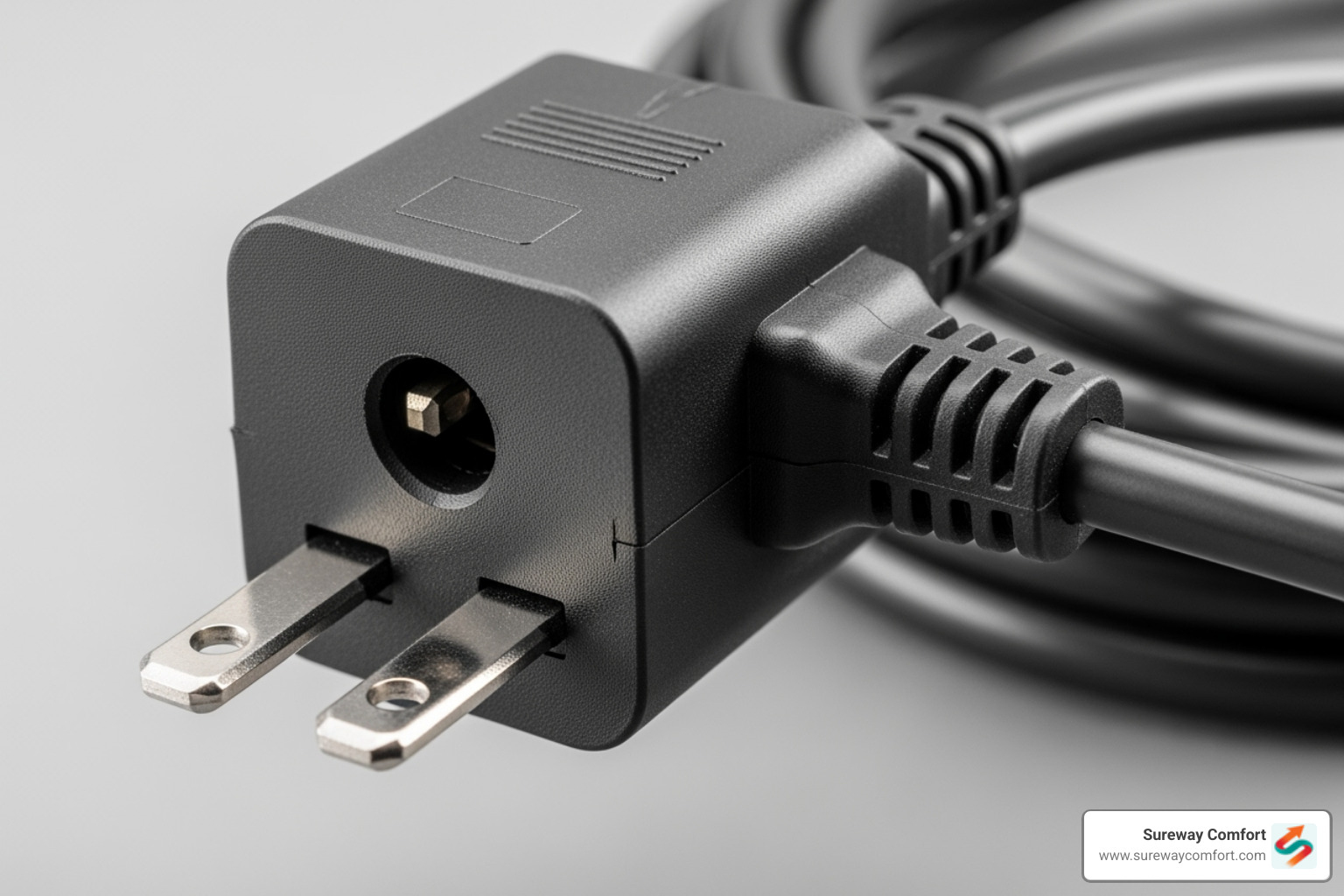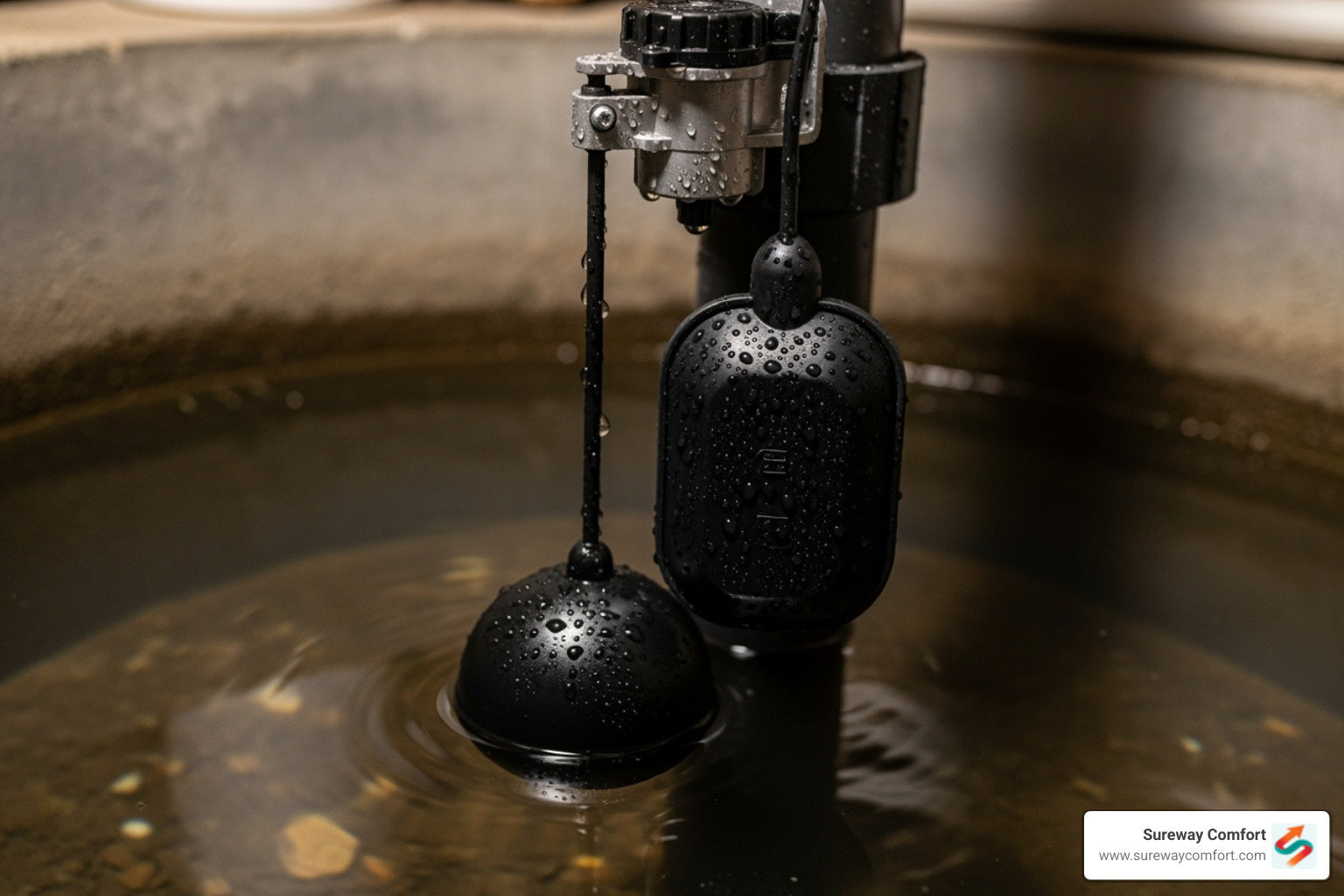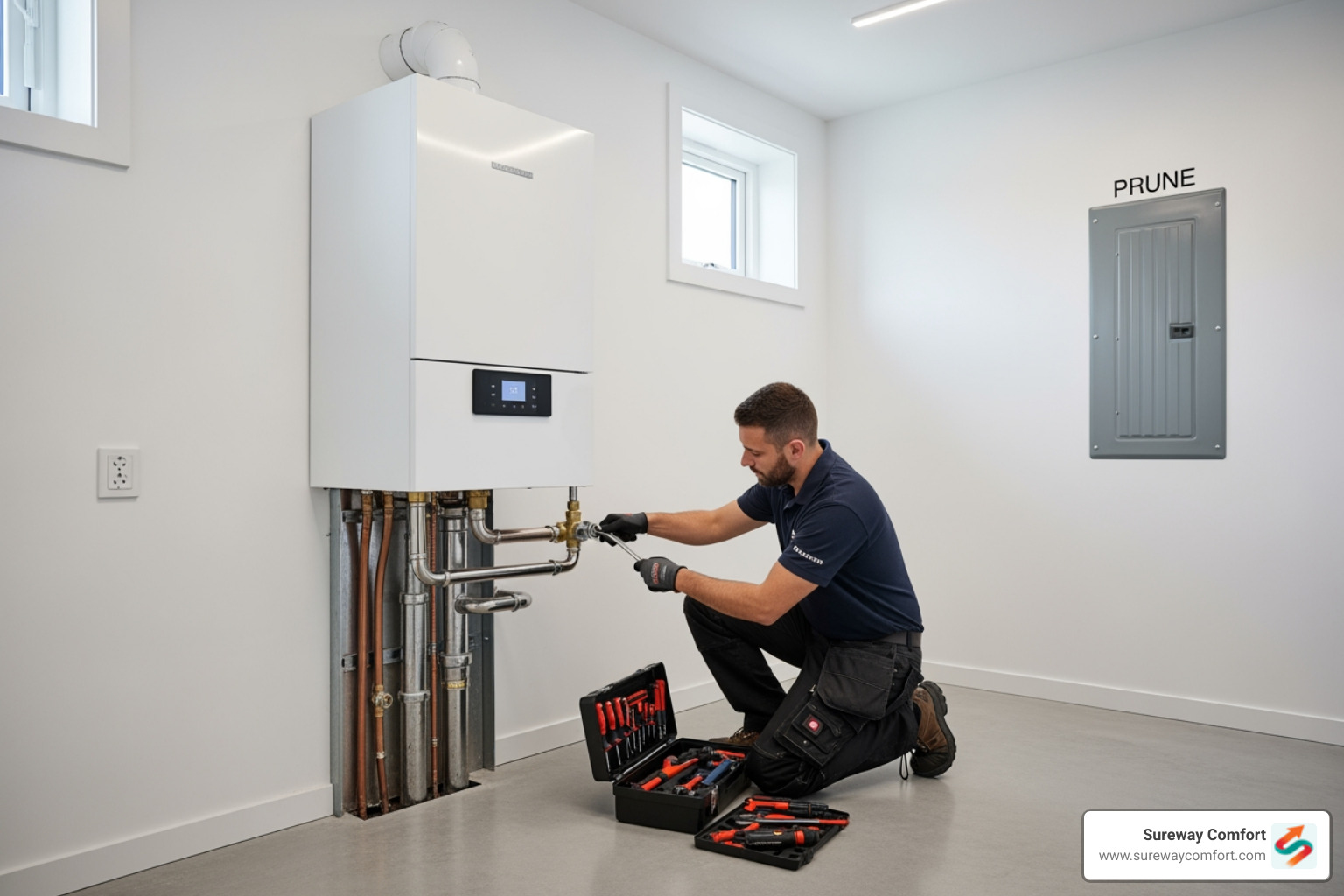Understanding Your Home's Hidden Flood Fighter
A sump pump float switch is the component that tells your pump when to turn on and off. It automatically detects rising water in your sump pit, triggers the pump to activate, and then deactivates it once the water level drops. This simple mechanism is your home's first line of defense against basement flooding, water damage, and expensive foundation repairs.
Similar to the float in a toilet tank, the switch's float rises with the water. When it reaches a set point, it activates the pump to remove the water. While the pump itself is important, it's useless without a reliable switch. A common point of failure is the float getting stuck between the pump and the sump pit wall, which can cause the entire system to fail when you need it most.
Understanding how your float switch works, the different types available, and how to maintain it can mean the difference between a dry basement and costly water damage. If you're experiencing issues with your sump pump or want to ensure your home is protected, contact Sureway Comfort for expert guidance and service.

What is a Sump Pump Float Switch and Why is it Critical?
Your sump pump float switch is the brain of your basement's water removal system. This liquid level sensor tells your sump pump exactly when to activate. As water fills the sump pit, the float rises with it. At a preset level, the switch turns the pump on, which pushes water safely away from your foundation. Once the water level drops, the switch turns the pump off. This automatic, 24/7 protection is what stands between you and a flooded basement.
A malfunctioning sump pump float switch can lead to disaster. If it fails in the "off" position, your pump won't activate, resulting in flooding, property damage, and potential harm to your home's foundation. If it gets stuck in the "on" position, your pump will run continuously, wasting energy and burning out the motor.
Beyond water damage, a failed switch can lead to standing water, which creates the perfect environment for mold and mildew growth, compromising your home's air quality. The simple mechanics of a float switch, similar to the float in a toilet tank, are critical for preventing these serious problems. You can read more about the general technology of float switches to understand their widespread use.
If you're concerned about your float switch's performance, contact Sureway Comfort for a professional inspection. Our technicians can ensure your system is working correctly and give you peace of mind.
Exploring the Different Types of Sump Pump Float Switches
Not all sump pump float switches are the same. The right one for your home depends on your sump basin's size, your desired pump cycle frequency, and reliability needs. Understanding the difference between mechanical and electronic options is key to making an informed choice.
Here's a quick comparison of the main types:
| Switch Type | Basin Size Suitability | Pump Cycle Length | Reliability |
|---|---|---|---|
| Tethered | Large (14"+ diameter) | Longer | Moderate |
| Vertical | Narrow/Small | Shorter | Moderate |
| Electronic | Any | Variable/Programmed | High |
Tethered Float Switches
A tethered float switch consists of a float attached to the pump by a flexible cord. As water rises, the float swings upward, activating the pump at a certain angle. This wide range of motion results in longer pump cycles, which can reduce wear on the motor. However, they require ample space and are best suited for large basins (14 inches or more in diameter). In smaller or crowded pits, the float can get tangled or wedged against the wall, causing failure. When we perform a Sump Pump Installation South Fayette PA, we always assess the basin size first.
Vertical Float Switches
For narrow or crowded sump basins, a vertical float switch is the ideal solution. The float on this type slides up and down a fixed rod. This compact, guided movement prevents it from getting stuck. Vertical switches provide consistent activation but typically have a shorter activation range, meaning the pump will cycle on and off more frequently. Over time, the guide rod can wear or bend, so it requires occasional inspection.
Electronic and Diaphragm Switches

Electronic sump pump float switches offer a major leap in reliability. They use sensors to detect water levels instead of moving parts that can get stuck or wear out. This solid-state design makes them exceptionally durable, often outlasting the pump itself. They work in any size basin and provide precise, maintenance-free operation, making them the gold standard for basement protection.
Diaphragm switches are another type that uses water pressure instead of a float. As water rises, it presses on a diaphragm to activate the pump. They are excellent for very shallow sumps or tight spaces where nearly complete water removal is needed.
A Note on Older Switch Types
You may have heard of older mercury switches, which used liquid mercury in a glass capsule to make an electrical connection. While reliable, they have been phased out due to the extreme toxicity of mercury. If the capsule were to break, it would create a serious health and environmental hazard. Modern electronic switches offer superior reliability without any of the associated risks.
If you're unsure which switch is right for your home, contact us at Sureway Comfort. Our technicians can recommend the best solution for your setup.
How to Choose, Install, and Test Your Sump Pump Float Switch
Selecting and installing the right sump pump float switch requires attention to detail to ensure your basement stays dry. Here's what you need to know to choose the correct switch and test it properly.

Key Specifications to Consider When Choosing a Sump pump float switch
To prevent electrical hazards and ensure proper function, your new switch must be compatible with your pump. Check the following specifications:
- Cord Length: Ensure the cord is long enough to reach the outlet while allowing the float to move freely, but not so long that it tangles.
- Voltage and Amperage: The switch's ratings must match or exceed your pump's requirements (e.g., 115V or 230V). A mismatch can cause switch failure or a fire hazard.
- Horsepower (HP) Rating: The switch must be rated to handle your pump's horsepower. Check your pump's nameplate and match it carefully.
- Pump Compatibility: If you have a sewage or effluent pump, you may need a specialized electronic switch designed to handle solids and debris.
- Configuration: For basement drainage, you need a 'pump down' (normally closed) switch, which turns the pump ON when water rises.
A Step-by-Step Guide to Installation and Testing
Proper installation is critical. If you're unsure about working with electrical components, it's best to call a professional. Our team handles Sump Pump Repair Bridgeville PA and can ensure your system is set up safely.
- Safety First: Always disconnect power to the sump pump at the outlet and circuit breaker before starting work.
- Plug It In: Many switches use a piggy-back plug, where the pump plugs into the back of the switch's plug. This allows the switch to control power to the pump. Ensure you use a GFCI-protected outlet.
- Secure the Cord: Attach the switch's cord to the discharge pipe, leaving enough slack for the float to move without hitting the pump or basin walls. For vertical switches, ensure the rod is secure and the float moves smoothly.
- Test with Water: Reconnect power and pour several buckets of water into the pit. The float should rise, activate the pump, and then shut the pump off as the water level drops.
- Perform a Manual Test: You can also carefully lift the float by hand to ensure it activates the pump and stops it when lowered. Never let the pump run dry.
Regular testing is the best way to confirm your system is ready for the next storm.
Common Problems, Maintenance, and Lifespan
Even the best sump pump float switch can fail without proper attention. Proactive maintenance is key to preventing floods and extending the life of your system.
Troubleshooting Common Sump pump float switch Issues
If your sump pump fails, the float switch is a likely culprit. Here are common issues:
- Stuck Float: Debris or tangled cords can wedge the float, preventing it from moving. If stuck down, the pump won't turn on. If stuck up, the pump will run continuously and burn out.
- Pump Won't Activate: Check for a stuck float, ensure the pump and switch are plugged into a working GFCI outlet, and look for any obstructions.
- Pump Runs Continuously: This usually indicates a float stuck in the "on" position or a clogged discharge pipe that prevents water from being removed.
- Mechanical Wear: Over time, the internal components of mechanical switches can corrode or wear out, leading to failure.
If you're dealing with persistent issues, our team can help. We handle Sump Pump Replacement Upper St. Clair PA and other repairs. Contact us for reliable service.
Essential Maintenance for Longevity
Consistent maintenance can prevent most switch problems. Follow these simple steps:
- Test Quarterly: Pour water into the sump pit every three months to confirm the system operates correctly. The float should rise, the pump should activate, and then it should shut off.
- Clean the Pit Annually: Unplug the pump and remove any dirt, gravel, or debris from the pit that could obstruct the float.
- Inspect the Switch: While cleaning, check the float and cord for wear or damage. Ensure it has a clear path to move freely.
What is the Typical Lifespan?
The lifespan of your sump pump float switch depends on its type and usage frequency.
- Mechanical Switches (Tethered & Vertical): These typically last three to seven years. The moving parts are subject to wear and can fail without warning. We recommend proactively replacing them every five years.
- Electronic Switches: With no moving parts, these are more durable, lasting five to ten years or more. Their reliability and longevity often justify a higher initial investment.
Replace your switch immediately if you notice intermittent operation, or if it fails to turn on or off correctly. Proactive replacement is a small price to pay for peace of mind.
Frequently Asked Questions about Sump Pump Float Switches
When is a vertical float switch a better choice than a tethered one?
A vertical float switch is the best choice for narrow or crowded sump pits (less than 14 inches in diameter). Its guided, up-and-down motion prevents it from getting tangled or stuck, a common problem for tethered switches which need more room to swing freely.
Can a float switch be used with different types of pumps?
Yes, a sump pump float switch can be used with sump, sewage, and effluent pumps, but only if the switch's electrical ratings (voltage, amperage, and horsepower) match or exceed the pump's requirements. Using an incompatible switch is a safety hazard. For pumps handling solids, an electronic switch is often the most reliable option. If you need help choosing, contact our team at Sureway Comfort.
How often should I test my float switch?
You should test your sump pump float switch at least quarterly (every three months) and after any major storm. Simply pour water into the pit to ensure the pump cycles on and off correctly. This simple test can identify problems before they lead to a flooded basement.
Your First Line of Defense Against a Flooded Basement
Your sump pump float switch is the small but essential hero that protects your basement from flooding. It works around the clock to detect rising water and activate your pump, preventing costly water damage, foundation issues, and mold growth. As we've covered, choosing the right type—whether tethered, vertical, or electronic—and performing regular maintenance are critical for reliable operation.
The most important takeaway is that proactive care is everything. Don't wait for a storm to find a problem. Regular testing and cleaning are essential practices for any homeowner. A few minutes of maintenance every few months can save you from a basement catastrophe.
If you need a professional inspection, are having issues with your current system, or need a replacement switch, the experienced technicians at Sureway Comfort are ready to help. We serve homeowners throughout Bridgeville, McDonald, Mt Lebanon, Bethel Park, Canonsburg, Collier, South Fayette, Upper St. Clair, Carnegie, Green Tree, Scott Township, Brookline, and Oakdale.
Don't leave your basement's protection to chance. Contact us for all your plumbing needs and let us ensure your home stays dry and secure.




























.avif)



